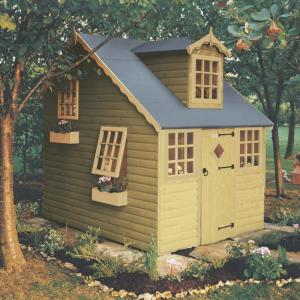With margins of +140% on high ticket items that cost the retailer virtually nothing to stock, this was something we really wanted to find more out about. So to find out how they do this Garden Trade Specialist interviewed WhatShed.co.uk, the UKs most authoritative website on garden buildings.
Ultimate Guide to Keeping Your Tools Secure at Home
In this post Andy Palmer, Master Locksmith at Grays Locksmiths, takes a look at how to keep your tools secure at home, in your garden and offers some tips.
Tool theft in the UK has increased by over 30 percent in the last full year, with tradespeople in Yorkshire and the Midlands particularly at risk. For those professionals that rely on their tools and equipment to get their jobs done, it’s important to take safety precautions
There are many ways that you can ensure tools and material goods are kept safe, from extra lighting around to storing your tools in a lock-tight storage box. While these tips will not guarantee your important items are always safe, it will strongly help deter theft and vandalism.
It may sound simple, but the harder your tools are to get to; the less likely thieves are to make off with them. It’s best to take your tools in from your vehicle overnight, as techniques like peel and steal can leave even well-secured vans vulnerable.
Garages are great for storing various items that you don’t want to get rid of but don’t have space for in your home. When you have so many valuables stored there, it’s important that you keep them safe. Garages and sheds can be prime targets for burglars. These tips will help to keep your garage safe and secure. Let start with the garage…
Lock the Door
This may sound simple, but just like you would in your home, make sure your garage door is locked – no matter whether you’re at home, or away. If you have a connecting door from your garage to your house, lock that too.
Thieves are opportunists and will seize their moment. If your garage door is unlocked, not only could they steal items stored in the garage, they may also try to enter your house.
Add Bolts
Garage doors often have a simple lock at the centre handle, which shouldn’t cause too many issues for the seasoned burglar.
To keep your garage safe, consider adding either a door bolt or padlock as another preventative method for would-be criminals. Even if just for a deterrent.
Install Motion-Sensor Lights
Whilst the installation of motion-sensor lights won’t cost much, they’re a great garage-safety hack. Garage lights can be dim, which is great news for burglars, as they have less chance of being caught… but that’s not good for you, or your tools.
Motion-sensor lights however, will light up both before and once the thief has entered the garage, notifying you and nearby neighbours. In most cases, burglars will run off when the lights turn on, keeping your garage safe.
Organise Your Stuff
It can be so easy just dumping stuff in your garage and forgetting about it, but that means it can be so much harder trying to find items.
Take the time to organise your garage so that you know where everything is. This might help you to identify whether or not something has been stolen.
Frost Your Windows
Not all garages have windows, but if you do, you may want to frost your garage windows, so passers-by can’t see what you keep in there.
You wouldn’t leave your phone or laptop by the window in your home, so why wouldn’t you follow the same safety precautions in your garage?
Hide the Remote Control
If you park your car in the garage and have an automated garage door, the simple option can be to keep the remote control in your car.
This is not good for garage safety however and should be avoided at all costs. If a criminal has gotten your car keys and the remote is in your car, they can make a quick getaway. Instead, hide the remote control in a safe place, or keep it in your bag.
Install an Alarm
Installing a burglar alarm – and setting it – will help to alert you, should any intruders attempt to break in. The noise alone should be enough to scare them off, keeping your valuables safe.
But you may keep your tools in the shed, whether it’s a private workspace, a place to escape to, or being used for storage space, there are usually many valuables in your shed.
People can underestimate the value of what’s in their shed, but they’ll often contain expensive bikes, tools and gardening equipment, making them an easy target for burglars. Sheds aren’t really designed to withstand a determined attack, but there are a few shed security tips you can follow to make your shed and the valuables in it less of a target.
Make Your Shed Hard to Access in the First Place
When positioning your shed, position it as near to your house as possible – at least ensure that you can see it easily from inside the house. Ideally, your shed should be positioned so that it cannot be seen from the street.
Additionally, ensure that your garden gates are secure and locked. You can use natural deterrents to good effect, too: place thorn bushes around the side of the shed to deter criminals, or place gravel around it so that anyone outside the shed will make a lot of noise.
Avoid Keeping Expensive Items in the Shed
Although sheds tend to become dumping grounds for what you can’t fit in your house, avoid keeping anything particularly expensive in the shed if possible, such as costly power tools or golf clubs.
Identify and Strengthen Weak Points
Before you start worrying about buying locks, start with the basics! Inspect the shed for any weak points or problem areas – look for rotten roof slats, rotten areas of the door or window frames. Then patch them up.
Don’t Display the Contents
At a basic level, you could use some old curtains to obscure the view from the outside.
Moving up the security scale and depending on the value of the contents of the shed, you may want to secure the windows. This could be done with laminated (toughened) glass, or by fixing a purpose-made grille against the windows on the inside of the shed.
Inspect the Hinges
Shed security can be improved by bolstering the quality of the hinges. If they’re loose and exposed, they’ll be easy to unscrew, particularly as sheds tend to use short screws. You could replace vulnerable-looking hinges with a new set that has a non-removable pin. Secure them with coach bolts, which have smooth heads so can’t be undone with a screwdriver.
Use Quality Locks
Fit a high-quality hasp and staple to the shed and secure this with coach bolts too. Use a quality padlock in combination with the hasp and staple – it’s recommended to use closed shackle padlocks. These have less of the hoop exposed so are harder for bolt cutters to cut.
For extra security, use two sets of hasps and staples and padlocks. Place one about one third down from the top of the door, and the other about one third up from the bottom.
Inside the shed, you can lock large items together with a chain or cable lock, making them even harder to access. A barbeque chained to a lawnmower isn’t going to be the easiest thing to get away with!
By following these security tips, you’ll have improved your garage and shed security, and ensured that it’s as hard as possible for would-be burglars to access your belongings. We hope you find these tips useful, there are lots of ways to keep your garage safe from intruders and keep your possessions protected.
- Log in to post comments


